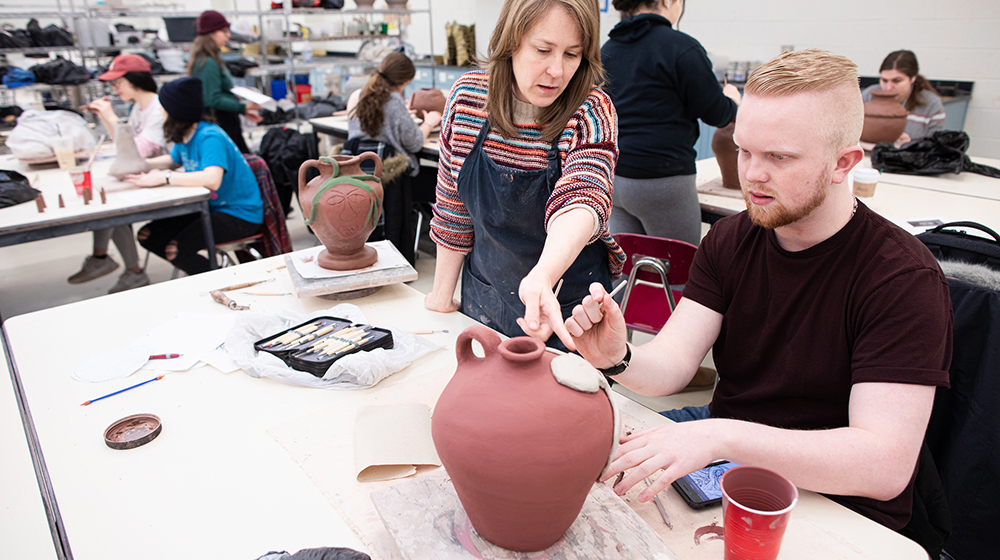Major in Sculpture and Ceramics

The Sculpture & Ceramics Major at Loyola University Chicago explores the interplay between Art, Craft & Design, and reflects on the vital contribution that three dimensional art forms make to material culture. Enhanced by a long history and a diversity of contemporary practice, the curriculum offers courses in 3D Design, Ceramics, Sculpture and Jewelry which investigate a variety of perspectives and approaches (conceptual, theoretical and empirical). The program is housed in the Ralph Arnold Fine Arts Annex at the Lakeshore Campus which feature recently renovated studio spaces for 3D Design, Sculpture, Ceramics, & Jewelry.
The major provides opportunity to develop unique capabilities which can be applied to a broad range of career paths. Students gain entry to higher education, or they can focus strategically on building a distinctive life in the visual arts though specialized production, promotion and collaboration. Many skills are transferrable for students interested in a career in the applied arts (interior architecture/product design/advertising & PR/theater & film/museums & galleries - exhibition design and production, props, sets, special effects etc.).
Learning Outcomes
Upon completion of this program, students will be able to:
- Apply a range of materials, processes and techniques within their chosen concentration as a primary form of artistic expression
- Engage in self-directed problem solving and critical thinking, and take creative and intellectual risks in the production of original artwork
- Employ scholarly and visual research in developing concepts that underlie their artistic intentions, and effectively communicate them orally and in written form
- Reflect on the creative process in relation to audience, current professional standards, and contemporary developments in art production, theory and criticism, and work independently in the development of cohesive bodies of work for professional exhibition
- Document artwork and artistic activity, and build portfolios relevant to the communication, dissemination and public display of creative work and artistic ideas
- Understand the place of art making in human creativity within a global historical context. Differentiate between artistic styles, and the multiplicity of populations and communities from which works of have been made (and are made), and engage in critical discussion with a depth of analysis and appreciation for aesthetic and conceptual diversity
Quick Links

The Sculpture & Ceramics Major at Loyola University Chicago explores the interplay between Art, Craft & Design, and reflects on the vital contribution that three dimensional art forms make to material culture. Enhanced by a long history and a diversity of contemporary practice, the curriculum offers courses in 3D Design, Ceramics, Sculpture and Jewelry which investigate a variety of perspectives and approaches (conceptual, theoretical and empirical). The program is housed in the Ralph Arnold Fine Arts Annex at the Lakeshore Campus which feature recently renovated studio spaces for 3D Design, Sculpture, Ceramics, & Jewelry.
The major provides opportunity to develop unique capabilities which can be applied to a broad range of career paths. Students gain entry to higher education, or they can focus strategically on building a distinctive life in the visual arts though specialized production, promotion and collaboration. Many skills are transferrable for students interested in a career in the applied arts (interior architecture/product design/advertising & PR/theater & film/museums & galleries - exhibition design and production, props, sets, special effects etc.).
Learning Outcomes
Upon completion of this program, students will be able to:
- Apply a range of materials, processes and techniques within their chosen concentration as a primary form of artistic expression
- Engage in self-directed problem solving and critical thinking, and take creative and intellectual risks in the production of original artwork
- Employ scholarly and visual research in developing concepts that underlie their artistic intentions, and effectively communicate them orally and in written form
- Reflect on the creative process in relation to audience, current professional standards, and contemporary developments in art production, theory and criticism, and work independently in the development of cohesive bodies of work for professional exhibition
- Document artwork and artistic activity, and build portfolios relevant to the communication, dissemination and public display of creative work and artistic ideas
- Understand the place of art making in human creativity within a global historical context. Differentiate between artistic styles, and the multiplicity of populations and communities from which works of have been made (and are made), and engage in critical discussion with a depth of analysis and appreciation for aesthetic and conceptual diversity
